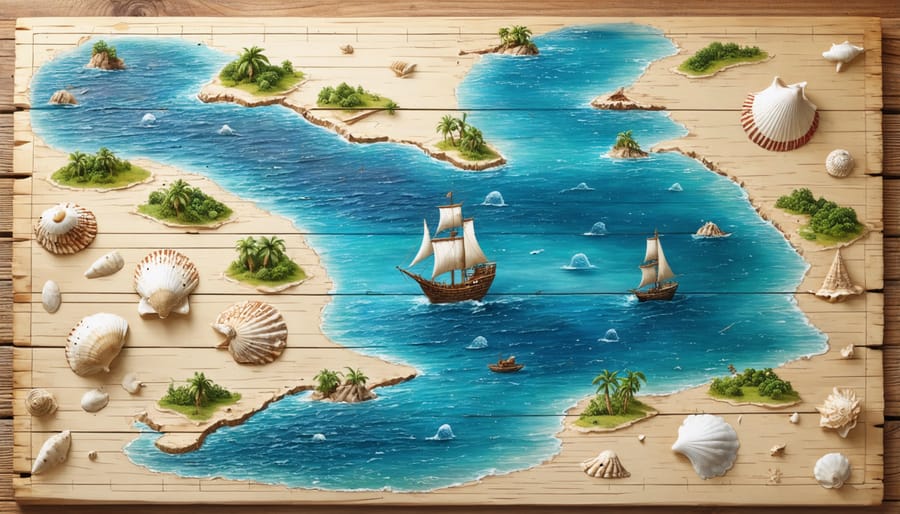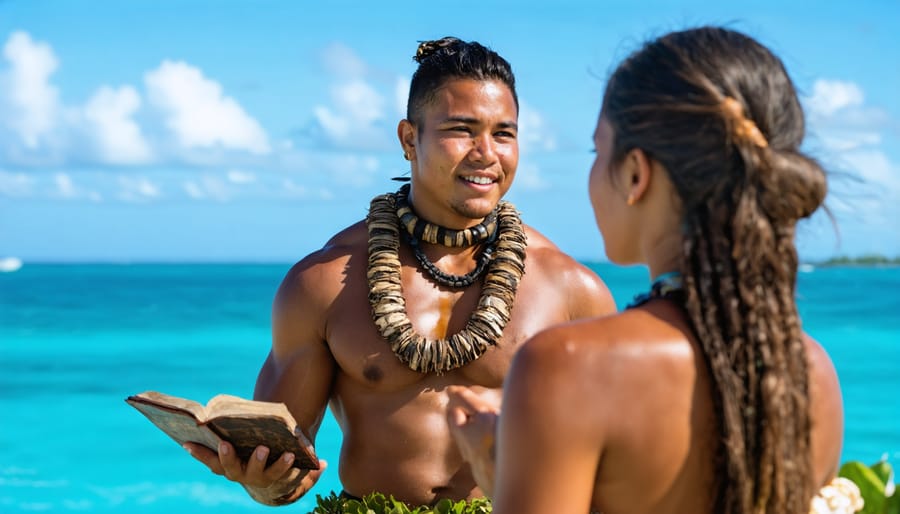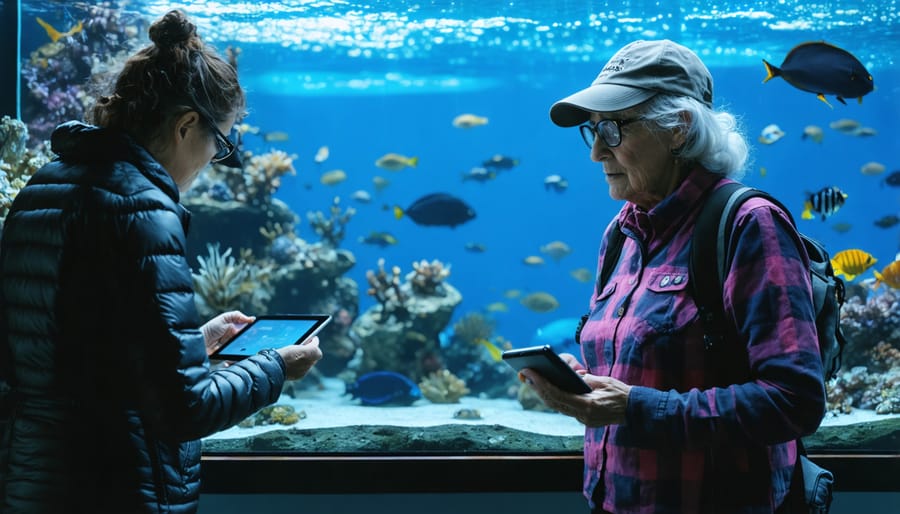
Dive into the vibrant world of Micronesian storytelling, where indigenous marine stories hold ancient wisdom crucial for modern ocean conservation. Across the vast Pacific archipelagos, generations of islanders have woven their intimate understanding of marine ecosystems into powerful narratives that map coral reefs, document species migrations, and encode sustainable fishing practices. These literary traditions, passed down through chants, legends, and oral histories, represent an untapped repository of ecological knowledge that bridges traditional wisdom with contemporary conservation science.
Today, as Micronesian communities face unprecedented environmental challenges, their literary heritage emerges as a vital tool for marine protection. From the Marshall Islands’ wave-finding stories that detail complex ocean current patterns to Palauan narratives that track seasonal fish spawning cycles, these indigenous texts offer precise, time-tested frameworks for understanding marine ecosystems. Modern conservation efforts increasingly recognize these narratives not merely as cultural artifacts, but as sophisticated scientific documents that have tracked environmental changes across centuries.
By integrating these traditional literary sources with current marine science, conservationists are developing more effective, culturally-informed approaches to protecting the Pacific’s rich biodiversity. This synthesis of ancient wisdom and modern research creates a powerful new paradigm for ocean conservation, one that honors indigenous knowledge while addressing contemporary environmental challenges.
The Ocean as Living History: Traditional Micronesian Narratives
Navigation Stories and Sea Knowledge
In Micronesian cultures, navigation stories serve as vessels of traditional marine knowledge, passing down centuries of oceanic wisdom through generations. These narratives intricately weave together practical seafaring techniques with spiritual connections to the ocean, creating a holistic understanding of marine ecosystems.
Master navigators, known as palu in many Micronesian societies, preserve their knowledge through oral traditions that describe wave patterns, star positions, and wildlife behavior. These stories often feature recurring characters who demonstrate the art of reading ocean swells, interpreting cloud formations, and following bird migration patterns. For instance, the tale of the “Navigator’s String” from the Caroline Islands illustrates how sailors used the movement of stars and ocean currents to maintain their bearing across vast distances.
The storytelling tradition extends beyond navigation to encompass detailed knowledge of marine species, their behaviors, and seasonal patterns. Narratives about fish migrations, coral reef ecology, and weather phenomena demonstrate sophisticated understanding of oceanographic principles that modern science has only recently confirmed. These stories often incorporate metaphorical elements that make complex marine concepts accessible while emphasizing the interconnectedness of human communities with ocean ecosystems.
Today, these navigation stories continue to inform contemporary marine conservation efforts, bridging ancient wisdom with modern environmental challenges. They provide valuable insights into sustainable fishing practices, climate patterns, and ecosystem management that remain relevant for current conservation strategies.

Creation Myths and Marine Biodiversity
The creation myths of Micronesian cultures reveal a sophisticated understanding of marine ecosystems that modern science is only beginning to fully appreciate. These oral traditions often describe intricate relationships between different marine species, seasonal patterns, and the delicate balance of coral reef ecosystems.
In many Micronesian creation stories, the ocean is portrayed not just as a setting but as a living entity that gives birth to islands and life itself. The Palauan creation myth, for instance, details how different fish species came to inhabit specific reef zones, closely matching contemporary scientific observations of marine habitat preferences.
These narratives frequently incorporate detailed knowledge about fish spawning cycles, migration patterns, and the interconnectedness of marine species. The Yapese stories about giant clams and their relationship with specific coral types demonstrate an understanding of symbiotic relationships that wasn’t documented by Western science until centuries later.
Traditional stories also often reference specific indicators of ecosystem health, such as the presence of certain fish species or coral formations. This knowledge, passed down through generations via oral literature, has proven invaluable for modern marine conservation efforts. Many contemporary conservation programs now incorporate these traditional ecological insights alongside scientific data to develop more effective preservation strategies.
By studying these creation myths, researchers and conservationists gain access to centuries of accumulated knowledge about marine biodiversity, helping bridge the gap between traditional wisdom and modern conservation approaches.
Contemporary Indigenous Voices in Marine Conservation

Environmental Activism Through Literature
Contemporary Micronesian writers are masterfully weaving traditional ecological knowledge into modern literature to address pressing environmental challenges. These authors draw from ancestral stories about the sacred relationship between islanders and their ocean environment to advocate for marine conservation and sustainable practices.
Notable writers like Kathy Jetnil-Kijiner from the Marshall Islands use poetry and prose to highlight the threats of climate change and ocean degradation. Her work “Tell Them” powerfully connects ancient stories of ocean stewardship with current indigenous marine conservation efforts, inspiring readers to protect marine ecosystems.
Traditional narratives about responsible fishing practices, marine species protection, and the interconnectedness of island ecosystems are being reimagined in contemporary forms. Writers incorporate ancient chants, myths, and legends that taught sustainable resource management into modern environmental literature, making these lessons accessible to new generations.
These literary works serve multiple purposes: they preserve cultural knowledge, educate readers about marine conservation, and inspire action. Stories about traditional navigation techniques, for instance, emphasize the deep understanding Micronesians have of ocean patterns and marine life behavior, knowledge that proves invaluable for modern conservation strategies.
Through their writing, these authors challenge readers to recognize the wisdom in traditional ecological practices while advocating for immediate action to protect threatened marine environments. Their work demonstrates how indigenous literature can be a powerful tool for environmental activism and marine biodiversity preservation.
Bridging Traditional and Scientific Knowledge
In Micronesia, a remarkable synergy exists between traditional ecological knowledge preserved in indigenous literature and modern marine science. Local communities have maintained oral histories and written accounts that detail centuries of observations about ocean currents, fish migration patterns, and reef health indicators. These traditional narratives often contain precise information about seasonal changes, species behavior, and sustainable fishing practices that align surprisingly well with contemporary scientific findings.
Marine biologists working in the region have discovered that indigenous stories about certain reef fish spawning grounds correspond exactly with their research data. For example, traditional Palauan fishing calendars, documented in both oral and written forms, accurately predict the timing of fish aggregations and coral spawning events. This knowledge has proven invaluable for conservation planning and marine protected area designation.
The integration of traditional and scientific knowledge has led to more effective conservation strategies. Local literature describing traditional conservation methods, such as periodic fishing closures and species-specific taboos, has helped inform modern marine resource management practices. These indigenous literary sources often contain detailed descriptions of ecosystem interactions that took Western science decades to formally document.
Scientists and indigenous knowledge holders now regularly collaborate on research projects, combining traditional ecological understanding with modern scientific methods. This partnership has enhanced our understanding of marine ecosystems while ensuring that conservation efforts respect and incorporate local cultural practices, creating more sustainable and culturally appropriate approaches to marine resource management.
Preserving Marine Heritage Through Stories
Digital Archives and Oral History Projects
Modern technology has revolutionized the preservation of Micronesian marine knowledge, combining traditional wisdom with digital accessibility. The Pacific Digital Library, launched in 2018, houses thousands of recorded stories from indigenous fishermen and navigators, documenting generations of expertise about ocean currents, fish migration patterns, and sustainable harvesting practices.
Notable projects include the Navigators’ Heritage Initiative, which uses interactive mapping technology to document traditional sailing routes and marine landmarks. Local youth actively participate in recording elders’ stories about marine life and conservation practices, creating a bridge between ancient knowledge and modern preservation methods.
The Marshall Islands Story Archive has pioneered innovative approaches to cultural preservation, using virtual reality technology to recreate traditional fishing grounds and document changing marine ecosystems. Their mobile recording units travel to remote atolls, capturing stories that might otherwise be lost to time.
These digital archives serve multiple purposes: they preserve indigenous knowledge for future generations, provide valuable data for marine conservation efforts, and offer educational resources for schools and research institutions. The combination of oral histories with modern technology has created a powerful tool for understanding and protecting Micronesia’s marine biodiversity.
Community-led initiatives, such as the Pohnpei Marine Tales Project, encourage active participation in both storytelling and marine conservation, ensuring that traditional knowledge continues to inform modern conservation practices.

Community-Led Conservation Programs
In Micronesia, traditional storytelling serves as a powerful foundation for modern community-based marine preservation initiatives. Local communities draw upon ancestral knowledge embedded in their oral traditions to inform contemporary conservation strategies. These stories, passed down through generations, contain detailed observations about marine species behavior, migration patterns, and sustainable fishing practices.
For instance, on Pohnpei Island, traditional narratives about the sacred relationship between people and marine life have inspired the creation of locally managed marine protected areas. Elders share stories that describe historical fishing grounds, spawning seasons, and the importance of maintaining ecosystem balance, which marine biologists now incorporate into conservation planning.
The integration of indigenous literature into conservation programs has proven particularly effective in engaging younger generations. Youth workshops combine traditional storytelling with modern scientific education, creating a bridge between cultural heritage and environmental stewardship. These programs have successfully established several marine sanctuaries where traditional management practices align with current scientific understanding.
Local communities have documented significant increases in fish populations and coral health in areas where traditional knowledge guides conservation efforts. The success of these initiatives demonstrates how indigenous literature continues to play a vital role in protecting Micronesia’s marine ecosystems while preserving cultural connections to the ocean.
The rich tapestry of indigenous Micronesian literature serves as more than just cultural heritage – it represents an invaluable repository of ecological knowledge that spans generations. These narratives, passed down through oral traditions and now preserved in written form, offer unique insights into sustainable marine resource management that modern conservation efforts are only beginning to fully appreciate.
Traditional stories about fishing practices, marine species behavior, and the delicate balance between human needs and ocean health demonstrate a sophisticated understanding of marine ecosystems that predates modern scientific methods. By incorporating these indigenous perspectives into contemporary conservation strategies, we can develop more effective and culturally sensitive approaches to protecting marine biodiversity.
The success of several recent conservation initiatives in Micronesia highlights the practical value of this literary heritage. When local communities share their traditional narratives with marine biologists and conservation teams, it often leads to more nuanced understanding of species migration patterns, breeding cycles, and sustainable harvesting practices. These collaborations have resulted in marine protected areas that honor both scientific principles and cultural values.
Looking ahead, the preservation and promotion of indigenous Micronesian literature will play a crucial role in future conservation efforts. Young environmental scientists and local community members alike can draw inspiration and practical guidance from these stories, creating a bridge between traditional ecological knowledge and modern conservation science. This integration helps ensure that conservation strategies remain culturally appropriate while addressing contemporary environmental challenges.
The time has come to recognize that indigenous narratives are not merely historical artifacts but living documents that can guide us toward more sustainable relationships with our oceans. By embracing these stories and the wisdom they contain, we strengthen our collective ability to protect marine ecosystems for future generations while honoring the cultural heritage that has sustained these waters for millennia.
jessica
Ava Singh is an environmental writer and marine sustainability advocate with a deep commitment to protecting the world's oceans and coastal communities. With a background in environmental policy and a passion for storytelling, Ava brings complex topics to life through clear, engaging content that educates and empowers readers. At the Marine Biodiversity & Sustainability Learning Center, Ava focuses on sharing impactful stories about community engagement, policy innovations, and conservation strategies. Her writing bridges the gap between science and the public, encouraging people to take part in preserving marine biodiversity. When she’s not writing, Ava collaborates with local initiatives to promote eco-conscious living and sustainable development, ensuring her work makes a difference both on the page and in the real world.
